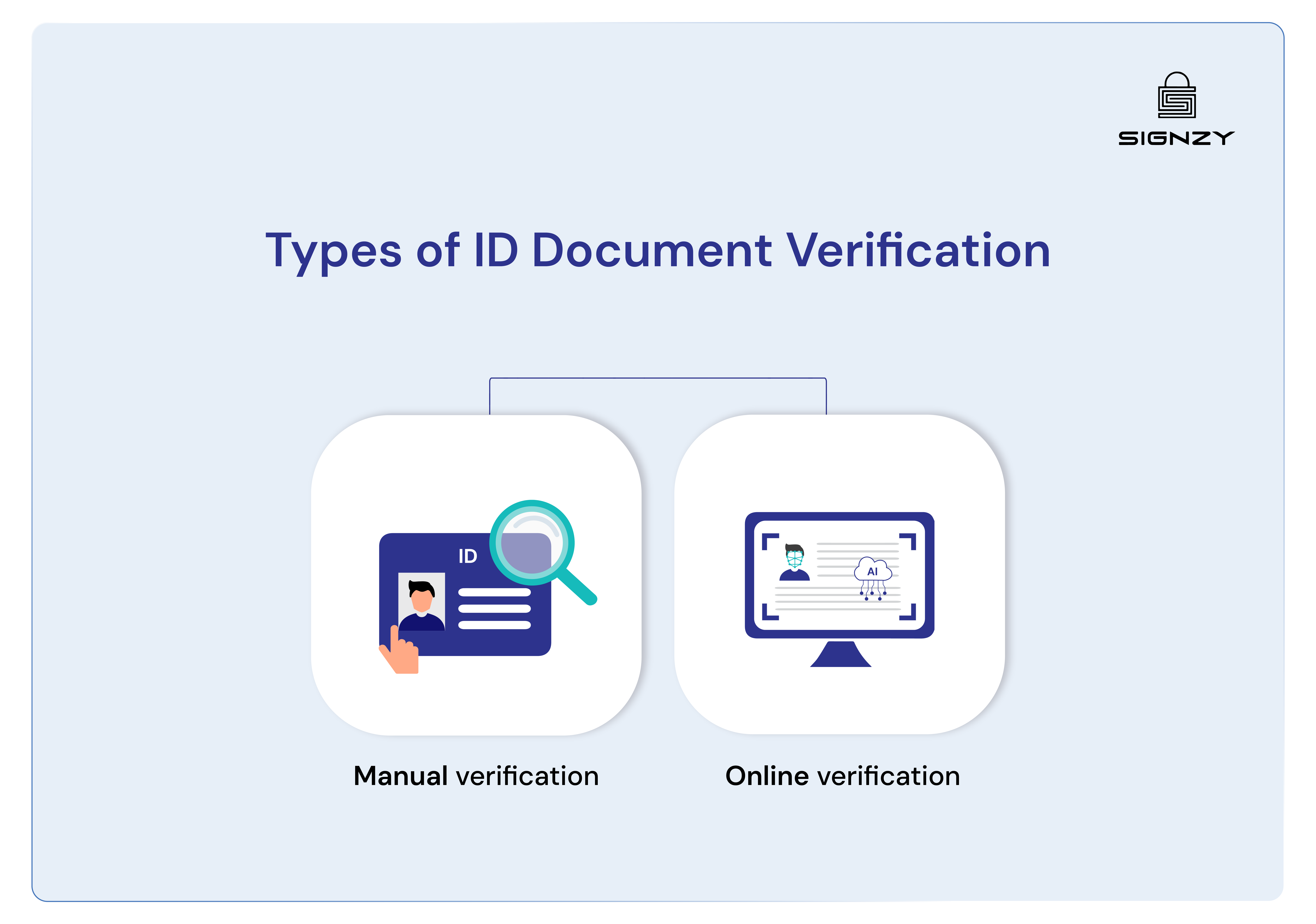How does ID document verification work?
What is ID Verification?
ID Document Verification is the process of validating and confirming a customer’s identity through several validity checks on their IDs.
Businesses use it to verify the authenticity of papers such as passports, driver’s licenses, voter ID cards, PAN cards, etc.
The verification process guarantees that the documents are not forged or tampered with, and confirms that the personal/business data is correct.
ID document verification systems compare the data on IDs to other types of identification documents or databases.
Data such as the name, address, date of birth, and photograph.
The verification process ensures that the information is correct and matches the identification of the person or entity submitting the document.
Types of ID Document Verification

Manual verification- It is the human evaluation and validation of papers, which relies on visual inspection and manual document checks. This may be useful for firms that only need to verify a few IDs, but it is error-prone, time-consuming, and unsuitable for high-volume cases.
Online verification- It uses Optical Character Recognition (OCR), AI, and machine learning to extract and authenticate data from different documents such as passports, driver’s licenses, and bank statements. This is accomplished by rule-based strategies, NFC checks, clever data matching algorithms, and such other methods.
Why is ID Verification important?
ID verification is important for businesses across different industries, including finance, e-commerce, and healthcare.
It assists businesses in determining their clients’ actual identity, guaranteeing that they are who they claim to be. And this helps to prevent fraud and financial loss while also protecting the company’s and its customers’ reputations.
💡 Related Blog:
Mitigating fraud using advanced algorithms
One of the primary advantages of ID verification is its capacity to prevent fraud.
Businesses can extract client information from IDs and verify its legitimacy using advanced algorithms.
To prevent fraudsters, these algorithms track eye movements, analyse texture and surface characteristics, and detect live pictures. This ensures that only real consumers are onboarded, lowering the likelihood of fraudulent activity.
Optimised image capture for better user experience
ID verification systems prioritise the user experience by pre-validating image captures.
Regardless of potential obstacles such as background, glare, low lighting, or several persons in the picture. They provide a smooth and seamless user experience. This avoids unnecessary customer delays and hassles, allowing for a quick and easy verification procedure.
Detecting fake IDs with advanced tech
Fraudsters are continuously changing their strategies, including creating sophisticated counterfeit IDs. However, with modern ID verification tools, organisations can detect even the most convincing fake IDs.
These systems use computer vision and machine learning techniques to detect text and photo modifications, guaranteeing that only legitimate IDs are approved.
Related Solutions
Where ID document Verification is needed?
ID document Verification is needed for remote client onboarding and user verification.
Companies can maximise their client onboarding and account opening by automating the ID verification process.
Effective AML KYC compliance requires document verification. Verify clients’ documents in real time and ensure regulatory compliance.
Age verification can easily confirm users’ age in age-restricted businesses. It can protect your company’s reputation by not allowing underage consumers to access age-restricted products.
ID verification process can help businesses ensure that the documents provided are authentic and valid.
How does document verification work?
Let’s see how document verification works.
First step is Document submission.
Many applications/software allow users to submit papers in-app and receive real-time response. This assures great image quality during the data extraction step of the document verification procedure.
After the users has uploaded their document, it is ready for data capture. The document verification system uses Optical Character Recognition (OCR) to convert the document’s image into text, making it easier to process for validation.
OCR and AI technologies are used to extract all important data from the document.
After all of the data has been extracted, it may be validated.
At this point, the document verification system examines the provided document for evidence of modification.
It checks for the possibility of fraud and uses security measures to evaluate information against trustworthy sources and guarantee that it fits the verification process’s requirements.
Some other common validation checks include-
EXIF data analysis is examining the Exchangeable Image File Format (EXIF) information embedded in digital files to validate document origins, dates, and times of creation, as well as photoshop activity to determine whether the image has been edited.
Grayscale analysis: When a photo is supplied, the document verification program can examine the document’s colour composition, with a concentration on the grayscale or black-and-white composition of the photo. This helps to detect suspected fraud and photo alteration.
Special feature identification: Some documents have security features such as watermarks, kinegrams, NFC, and holograms. These characteristics are generally difficult to imitate, and their existence or absence might indicate a document’s genuineness.
ID verification is a critical component of regulated industries such as finance and healthcare. Users should feel secure and confident while making financial transactions, and companies must minimise the risk of fraud and breaches at all stages of the process.
Cross-check validation: Documents may contain information that can easily be cross-verified. Cross-check validation is comparing information collected from a document to external databases or reliable sources.
Check for completeness: Many document types follow a defined pattern and have pre-defined sections and information. With completeness checks, it can be ensured that all required components or pieces are present in a document. This includes carefully reviewing critical fields, signatures, and mandatory parts.
ID verification is vital for the safety of financial transactions
ID verification is a critical component of regulated industries such as finance and healthcare. Users should feel secure and confident while making financial transactions, and companies must minimise the risk of fraud and breaches at all stages of the process.
With breakthroughs in AI and machine learning, the accuracy and efficiency of ID verification and quality checks have greatly improved. As technology advances, further advancement can be expected in this field.
Investing in modern verification technologies can differentiate your company and boost consumer trust while lowering risks and liabilities.
If you are searching for a reliable solution, reach out to us today!

Agrima Dwivedi
Agrima is an Associate Product Marketer at Signzy, currently working in the B2B fintech space. She brings over two years of experience in copywriting and content writing, which laid the foundation for product marketing. Today, she leverages both creative and strategic skills to drive go-to-market efforts and build user-focused marketing strategies.


